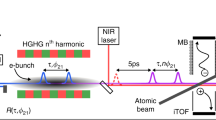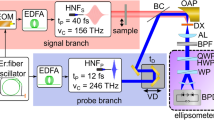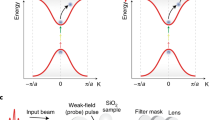Abstract
The ability to probe quantum systems on short timescales is central to the advancement of quantum technology. Here we show that this is possible using an off-resonant dispersive probe. By applying a magnetic field to an atomic vapour the spectra of the group index for left and right circularly polarized light become displaced, leading to a slow-light Faraday effect that results in large dispersion and high transmission over tens of gigahertz. This large frequency range opens up the possibility of probing dynamics on a nanosecond timescale. In addition, we show that the group index enhances the spectral sensitivity of the polarization rotation, giving large rotations of up to 15π rad for continuous-wave light. Finally, we demonstrate dynamic broadband pulse switching by rotating a linearly polarized nanosecond pulse by π/2 rad with negligible distortion and transmission close to unity.
This is a preview of subscription content, access via your institution
Access options
Subscribe to this journal
Receive 12 print issues and online access
$209.00 per year
only $17.42 per issue
Buy this article
- Purchase on Springer Link
- Instant access to full article PDF
Prices may be subject to local taxes which are calculated during checkout






Similar content being viewed by others
References
Krauss, T. F. Why do we need slow light? Nature Photon. 2, 448–450 (2008).
Hau, L. V., Harris, S. E., Dutton, Z. & Behroozi, C. H. Light speed reduction to 17 metres per second in an ultracold atomic gas. Nature 397, 594–598 (1999).
Vanner, M. R., McLean, R. J., Hannaford, P. & Akulshin, A. M. Broadband optical delay with a large dynamic range using atomic dispersion. J. Phys. B 41, 051004 (2008).
Camacho, R. M., Pack, M. V., Howell, J. C., Schweinsberg, A. & Boyd, R. W. Wide-bandwidth, tunable, multiple-pulse-width optical delays using slow light in Cesium vapor. Phys. Rev. Lett. 98, 153601 (2007).
Tanaka, H. et al. Propagation of optical pulses in a resonantly absorbing medium: observation of negative velocity in Rb vapor. Phys. Rev. A 68, 053801 (2003).
Gauthier, D. J., Gaeta, A. L. & Boyd, R. W. Slow light: from basics to future prospects. Photon. Spectra 40, 44–50 (2006).
Fleischhauer, M. & Lukin, M. D. Dark-state polaritons in electromagnetically induced transparency. Phys. Rev. Lett. 84, 5094–5097 (2000).
Liu, C., Dutton, Z., Behroozi, C. H. & Hau, L. V. Observation of coherent optical information storage in an atomic medium using halted light pulses. Nature 409, 490–493 (2001).
Phillips, D. F., Fleischhauer, A., Mair, A., Walsworth, R. L. & Lukin, M. D. Storage of light in atomic vapor. Phys. Rev. Lett. 86, 783–786 (2001).
Shi, Z., Boyd, R. W., Gauthier, D. J. & Dudley, C. C. Enhancing the spectral sensitivity of interferometers using slow-light media. Opt. Lett. 32, 915–917 (2007).
Purves, G. T., Adams, C. S. & Hughes, I. G. Sagnac interferometry in a slow-light medium. Phys. Rev. A 74, 023805 (2006).
Shi, Z., Boyd, R. W., Camacho, R. M., Vudyasetu, P. K. & Howell, J. C. Slow-light fourier transform interferometer. Phys. Rev. Lett. 99, 240801 (2007).
Urban, E. et al. Observation of Rydberg blockade between two atoms. Nature Phys. 5, 110–114 (2009).
Gae¨tan, A. et al. Observation of collective excitation of two individual atoms in the Rydberg blockade regime. Nature Phys. 5, 115–118 (2009).
Aharonov, Y., Albert, D. Z. & Vaidman, L. How the result of a measurement of a component of the spin of a spin-1/2 particle can turn out to be 100. Phys. Rev. Lett. 60, 1351–1354 (1988)
Hosten, O. & Kwiat, P. Observation of the spin Hall effect of light via weak measurements. Science 319, 787–790 (2008).
Budker, D. et al. Resonant nonlinear magneto-optical effects in atoms. Rev. Mod. Phys. 74, 1153–1201 (2002).
Awschalom, D. D. & Kikkawa, J. M. Electron spin and optical coherence in semiconductors. Phys. Today 52, 33–38 (1999).
Atatu¨re, M., Dreiser, J., Badolato, A. & Imamoglu A. Observation of Faraday rotation from a single confined spin. Nature Phys. 3, 101–106 (2007).
Menders, J., Benson, K., Bloom, S. H., Liu, C. S. & Krevaar, E. Ultranarrow line filtering using a Cs Faraday filter at 852 nm. Opt. Lett. 16, 846–848 (1991).
Grischkowsky, D. Adiabatic following and slow optical pulse propagation in rubidium vapor. Phys. Rev. A 7, 2096–2103 (1973).
Siddons, P., Adams, C. S., Ge, C. & Hughes, I. G. Absolute absorption on rubidium D lines: comparison between theory and experiment. J. Phys. B 41, 155004 (2008).
Kahla, S. & Grishin, A. M. Enhanced Faraday rotation in all-garnet magneto-optical photonic crystal. Appl. Phys. Lett. 84, 1438–1440 (2004).
Pearman, C. P. et al. Polarization spectroscopy of a closed atomic transition: applications to laser frequency locking. J. Phys. B. 35, 5141–5151 (2002).
Mohapatra, A. K., Jackson, T. R. & Adams, C. S. Coherent optical detection of highly excited Rydberg states using electromagnetically induced transparency. Phys. Rev. Lett. 98, 113003 (2007).
Mohapatra, A. K., Bason, M. G., Butscher, B., Weatherill, K. J. & Adams, C. S. A giant electro-optic effect using polarizable dark states. Nature Phys. 4, 890–894 (2008).
Mauger, S., Millen, J. & Jones, M.P.A. Spectroscopy of strontium Rydberg states using electromagnetically induced transparency. J. Phys. B 40, F319–F325 (2007).
Gibbs H. M., Churchill, G. G. & Salamo, G. J. Faraday rotation under cw saturation and self-induced transparency conditions. Opt. Commun. 12, 396–399 (1974).
Hammerer, K., Sorensen, A. S. & Polzik, E. S. Quantum interface between light and atomic ensembles. arXiv:0807.3358v2 [quant-ph] (2008).
Boyd, R. W. Nonlinear Optics, 3rd edn (Academic Press, 2008).
Huard, S. Polarization of Light (Wiley, 1997).
McCarron, D. J., Hughes, I. G., Tierney, P. & Cornish, S. L. A heated vapor cell unit for dichroic atomic vapor laser lock in atomic rubidium. Rev. Sci. Instrum. 78, 093106 (2007).
Acknowledgements
The authors would like to thank M.P.A. Jones for valuable discussion. This work was funded by the Engineering and Physical Sciences Research Council (EPSRC).
Author information
Authors and Affiliations
Contributions
P.S. carried out the experiment and theoretical modelling, and contributed to the writing of the paper. N.C.B. and Y.C. assisted with the experiment. C.S.A. and I.G.H contributed to the writing of the paper and were responsible for project management.
Corresponding author
Rights and permissions
About this article
Cite this article
Siddons, P., Bell, N., Cai, Y. et al. A gigahertz-bandwidth atomic probe based on the slow-light Faraday effect. Nature Photon 3, 225–229 (2009). https://doi.org/10.1038/nphoton.2009.27
Received:
Accepted:
Published:
Issue Date:
DOI: https://doi.org/10.1038/nphoton.2009.27
This article is cited by
-
Direct investigation of the atomic structure and decreased magnetism of antiphase boundaries in garnet
Nature Communications (2022)
-
Na-Faraday rotation filtering: The optimal point
Scientific Reports (2014)
-
Experimental demonstration of spinor slow light
Nature Communications (2014)
-
Mode splitting of a cavity with a high-density birefringence rubidium vapor in the superstrong coupling regime
Science China Physics, Mechanics & Astronomy (2014)
-
Quasi-phase-matching of momentum and energy in nonlinear optical processes
Nature Photonics (2010)



